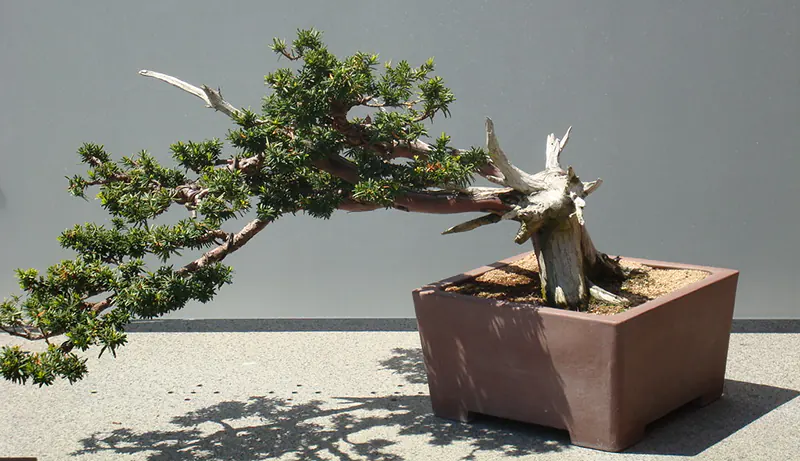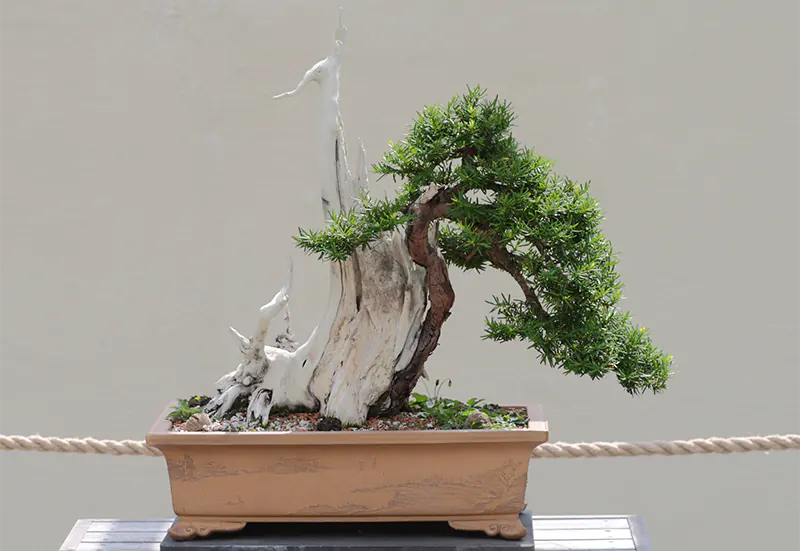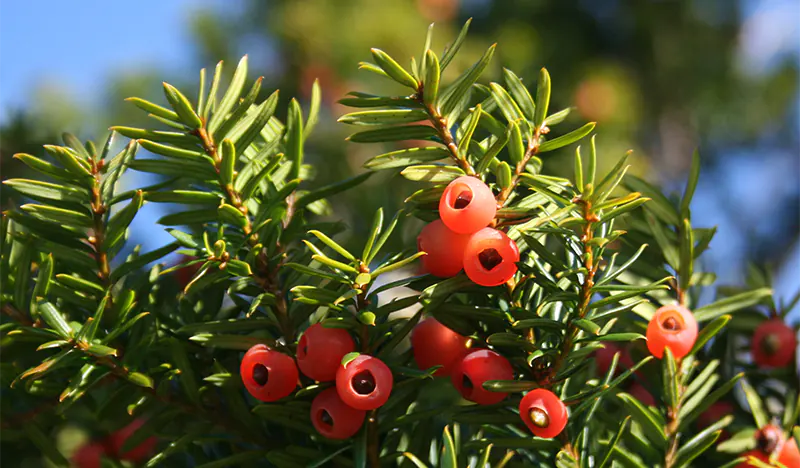Japanese Yew Bonsai Pests and Diseases Guide
Japanese Yews (Taxus cuspidata) are hardy evergreen trees that can grow into magnificent bonsai specimens.
Generally, Japanese Yews are pretty hardy and will tolerate some rough handling, but they will succumb to pests and diseases if not correctly cared for, like any plant. Image courtesy of 4.0 International
Image courtesy of 4.0 International
Diseases Commonly Found in Japanese Yew
Here are some of the top diseases you may encounter on your Japanese Yew bonsai.
Root Rot
One of the major causes of poor growth or even death of Japanese Yew plants is water. These plants cannot tolerate standing in water. When water sits in the soil, it depletes the oxygen in the ground and damages the roots of the Yew.
What to Look For in Root Rot
With damaged roots, the plant can’t absorb the water and nutrients it requires, and soon the leaves will start to turn yellow. The plant will die if the water is not drained off.
How to Treat Root Rot
Ensure that your Japanese Yew is planted in a quick draining medium, and when watering, ensure that the water drains away and does not remain locked into the pot.
Armillaria Root Rot
Armillaria is a highly aggressive pathogen that can kill your Japanese Yew in a concise space of time.
This fungus attacks the tree’s base and kills the cambium, which lies just below the bark. This results in the death of the plant in a very short space of time.
What to Look For in Armillaria Root Rot
The most visible symptom of an armillaria infection is the growth of mushrooms that are the color of honey around the tree’s base. These are the fruit bodies of the armillaria fungus.
How to Treat Armillaria Root Rot
There is no way to treat this fungus.
In the garden, remove and burn the affected plants and do not plant anything susceptible to this fungus in its place.
If this is a bonsai specimen, remove the infected plant and burn it. Either completely discard the growing medium or ensure that it is baked to kill the spores in the medium. Any rocks or other decorative items and the pot must be thoroughly washed with a strong anti-fungal solution to kill any spores. Image courtesy of 3.0 Unported
Image courtesy of 3.0 Unported
Pests Commonly Found in Japanese Yew
Small insects and other pests can also damage your Japanese Yew bonsai. Here are the ones to look out for.
Black Vine Weevil (Otiorhynchus sulcatus)
This weevil, also known as the taxus weevil, affects the Yew’s roots and leaves.
How to Identify Black Vine Weevil
The white, C-shaped, legless larva has a red-brown head and is found in the soil around the roots of the Yew. The larva eats the roots of the Yew and interrupts the transfer of water and nutrients to the plant.
The larva pupate in white pupae that have prominent antennae and legs. These pupae can be found close to the surface of the ground.
The shiny, black adult is small (± ½” long) and creeps out of the earth at night to feed. If disturbed, it will drop to the ground, where it is almost impossible to see due to its color.
If you suspect this pest, check the needles close to the stem at the center of the plant. If you see small semi-circular notches nibbled into the edge of the needles, you can be sure that this weevil is the culprit.
How to Get Rid of the Black Vine Weevil
In light infestations, this weevil will not do much damage to your plant. As the female can lay as many as 500 eggs, the infestation will increase, and so will the damage, so it is worth nipping any infestation in the bud.
Pesticides can be applied to destroy the adult weevils and prevent reinfestation.
Mealybugs
Mealybugs are part of the order Homoptera, with close relatives being the scales, aphids, and whiteflies.
How to Identify Mealybugs
Mealybugs can be identified by the white, waxy secretion that covers their bodies.
Female Mealybugs are ± ⅛” long and have an oval body, characterized by its white, waxy appearance. Male Mealybugs are tiny, winged creatures that emerge, mate and die on the same day.
Mealybugs infest all plant parts but are mostly found underneath the needles. Their mouthparts are sharp, and they pierce the plant’s skin and suck the sap.
Mealybugs excrete a sticky honeydew that’s quickly covered with a black mold, giving the plant a dirty, sooty appearance. This honeydew also attracts ants who love this sticky substance. Ants may also move the Mealybugs from one plant to another.
As the Mealybug infestation deepens, the Yew will show all the signs of lack of food. Leaves will turn yellow and start to drop. Left unchecked, Mealybugs will destroy the plant.
How to Get Rid of Mealybugs
It is simple to pick the Mealybugs off the plants using a cotton bud soaked in an alcohol solution, or commercial insecticides can kill the adults.
Many predatory insects will keep infestations in check. These include certain species of wasps, ladybugs, syrphid flies, and lacewings. Encourage these insects by minimizing the use of insecticides.
Scale Insects
Scale insects are widespread and found in two types: armored scale and soft body scale. Armored scale insects can quickly destroy a plant, while the soft body insect is a pest rather than destructive.
How to Identify Scale Insects
Scale is quickly identified by their body color, which appears as a different colored lump on the surface of a stem or leaf. It can be flicked off using a fingernail or the tip of a knife.
Plants infested with armored scales will lose condition quickly. These insects pierce the skin of the plant and suck out the sap. In a short time, the leaves will turn yellow, and twigs will die. As the infestation deepens, the plant will become more stressed and eventually die.
Plants with soft-scale infestations will not be killed by the insects, but they do excrete a honeydew similar to that of Mealybugs, and the same black mold will grow, and ants will be attracted. These are all undesirable, so the soft scale insects should also be eliminated.
How to Get Rid of Scale Insects
Management of scale insects is the same as for Mealybugs. Encourage predatory insects, especially ladybugs, and if the infestation cannot be controlled by predators or by manually removing the scale, insecticides will be the only answer.
Root-knot Nematodes
Root-knot Nematodes are tiny roundworms that belong to the genus Meloidogyne. These microscopic worms are usually found in sandy soils, so the well-drained soils of bonsai plants make an ideal home.
How to Identify Root-knot Nematodes
If our Yew is infected with this nematode, the plant will exhibit all the signs of nutrient deficiency. The growth will be stunted, and the yellow leaves will look wilted.
If the plant has these symptoms and is not cleared by careful nurturing, lift the plant and examine the root structure. If the roots are swollen and knotted with galls that can’t be rubbed off, then it is reasonable to diagnose an infection by this nematode.
How to Get Rid of Root-knot Nematodes
The only way to destroy this pest is to destroy the plant and burn it – do not add it to your compost heap. The soil cannot be used again and should be discarded. If this is in the garden, do not plant anything susceptible to this pest, in the same position, for at least five years. Image courtesy of 3.0 Unported
Image courtesy of 3.0 Unported
Conclusion
The Japanese Yew is a hardy plant that will provide a wonderful garden and bonsai specimen. A few pests may bother your plant, but standard good husbandry practices will ensure a magnificent specimen that may become a family heirloom.






